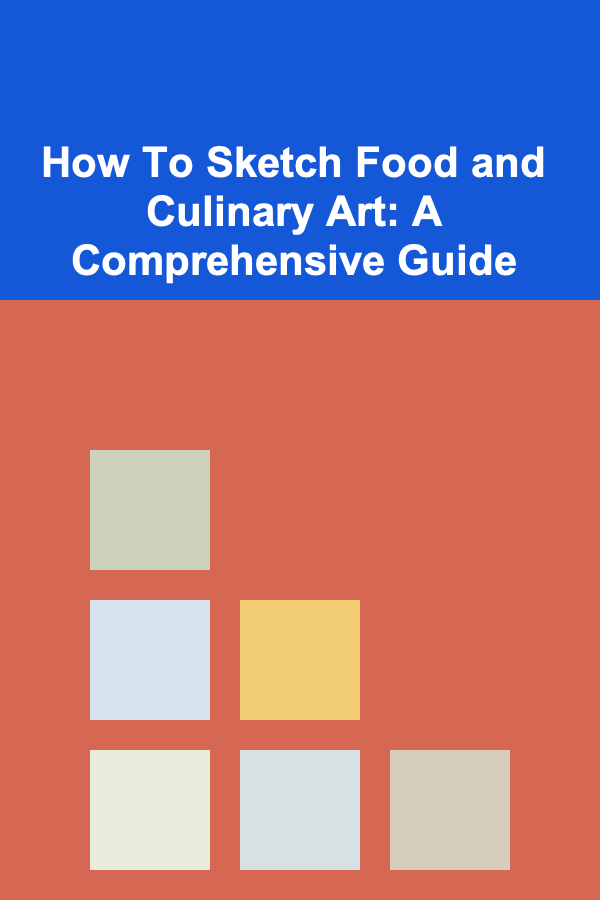
How To Sketch Food and Culinary Art: A Comprehensive Guide
ebook include PDF & Audio bundle (Micro Guide)
$12.99$9.99
Limited Time Offer! Order within the next:

Sketching food and culinary art is a delightful and rewarding way to capture the beauty, texture, and even the imagined aromas of the culinary world. It's more than just creating a visual representation; it's about understanding form, light, shadow, and the essence of what makes a dish appealing. Whether you're a seasoned artist or just starting out, this guide will provide you with the knowledge and techniques to create compelling and mouthwatering food sketches.
I. Laying the Groundwork: Essential Materials and Fundamentals
A. Gathering Your Tools
The beauty of sketching is that you don't need a vast array of expensive materials to get started. A few essential tools will suffice, and you can gradually expand your collection as you develop your skills.
- Sketchbook or Paper: Start with a smooth or slightly textured paper. For dry media like graphite or charcoal, a sketchbook with a weight of at least 70lb (110 gsm) is recommended. If you plan on using wet media like watercolor, opt for watercolor paper with a weight of at least 140lb (300 gsm). Experiment with different paper types to find what suits your style best.
- Pencils: A range of graphite pencils is essential. Harder pencils (2H-4H) are excellent for light outlines and preliminary sketches, while softer pencils (2B-6B) are ideal for shading and creating darker tones. A mechanical pencil with various lead thicknesses can also be very useful for details.
- Erasers: A kneaded eraser is perfect for lifting graphite without damaging the paper. A plastic or rubber eraser is useful for more precise corrections. A precision eraser or eraser shield can help erase fine details without affecting surrounding areas.
- Sharpeners: A good quality pencil sharpener is crucial for maintaining sharp points. Consider using a hand-held sharpener or a rotary sharpener.
- Blending Tools (Optional): Blending stumps, tortillons, cotton swabs, or even your fingers can be used to soften and blend graphite or charcoal for smoother transitions.
- Watercolor Paints and Brushes (Optional): If you're planning to incorporate watercolor, invest in a basic watercolor palette and a few round and flat brushes of different sizes.
- Colored Pencils (Optional): Colored pencils can add vibrancy and realism to your food sketches. Choose a set with a range of colors and good lightfastness.
- Pens (Optional): Fine liner pens, brush pens, or ink pens can be used to create outlines, add details, and define shapes.
B. Understanding Basic Shapes and Forms
All objects, including food, can be broken down into basic geometric shapes such as spheres, cubes, cylinders, cones, and pyramids. Learning to see these shapes within complex forms is fundamental to creating accurate and convincing sketches.
- Observe Carefully: Before you start sketching, spend time observing your subject. Identify the dominant shapes and how they relate to each other.
- Start with Simple Shapes: Begin by sketching the basic shapes that make up the overall form of the food item. Don't worry about details at this stage.
- Refine and Adjust: Gradually refine the shapes, adding curves, angles, and other details to create a more accurate representation.
- Practice Regularly: Practice sketching simple objects like fruits, vegetables, and kitchen utensils to develop your ability to see and represent forms accurately.
C. Mastering Light and Shadow
Light and shadow are essential for creating depth and dimension in your sketches. Understanding how light interacts with different surfaces is crucial for conveying form and texture.
- Identify the Light Source: Determine the direction and intensity of the light source. This will dictate the placement and intensity of the shadows.
- Observe the Highlights: Highlights are the brightest areas of an object, where the light hits directly. They define the form and add a sense of realism.
- Understand the Shadows: Shadows are the areas of an object that are not directly illuminated. There are several types of shadows:
- Cast Shadows: Shadows that are projected onto surrounding surfaces.
- Form Shadows: Shadows that occur on the object itself, due to its shape.
- Core Shadows: The darkest part of the form shadow, typically located near the terminator (the line separating the light and shadow).
- Use Value to Create Depth: Value refers to the lightness or darkness of a tone. Use a range of values to create contrast and depth in your sketches.
- Practice Shading Techniques: Experiment with different shading techniques, such as hatching, cross-hatching, stippling, and blending, to create different textures and effects.
II. Sketching Specific Food Items: Techniques and Tips
A. Fruits and Vegetables: Capturing Texture and Color
Fruits and vegetables offer a wonderful opportunity to practice your sketching skills. Their diverse shapes, colors, and textures provide endless inspiration.
- Apples: Start with a basic sphere and then add the characteristic dimple at the top and bottom. Pay attention to the subtle curves and irregularities of the apple's surface. Use hatching and cross-hatching to create the smooth, shiny texture. Consider adding subtle color variations using colored pencils or watercolor.
- Grapes: Sketch individual grapes as overlapping spheres. Pay attention to the highlights and shadows on each grape to create a sense of volume. Use a fine liner pen to add details like the stem and the subtle texture of the skin.
- Citrus Fruits (Oranges, Lemons, Limes): Start with a sphere and then add the characteristic texture of the rind. Use stippling or hatching to create the dimpled surface. Capture the bright, vibrant colors using colored pencils or watercolor. Consider sketching slices to reveal the juicy segments inside.
- Leafy Greens (Lettuce, Spinach): Leafy greens can be challenging to sketch due to their complex shapes and textures. Start by sketching the overall form of the leaf and then gradually add the details of the veins and edges. Use light, flowing lines to capture the organic shapes. Experiment with different shading techniques to create the crinkled texture.
- Tomatoes: Start with a sphere and pay attention to the subtle bumps and imperfections on the skin. Use soft shading to create the smooth, shiny texture. Add the stem and calyx at the top.
B. Breads and Pastries: Emphasizing Crust and Crumbs
Sketching breads and pastries requires attention to detail and an understanding of texture. The crust, crumb, and overall form all contribute to the appeal of these delicious treats.
- Loaves of Bread: Start by sketching the overall shape of the loaf, paying attention to the curves and proportions. Then, focus on the crust, adding details like cracks, blisters, and imperfections. Use hatching and cross-hatching to create the rough, textured surface. Use darker values to indicate the baked color of the crust.
- Croissants: Croissants are characterized by their crescent shape and flaky layers. Start by sketching the overall shape and then add the individual layers. Use light, curved lines to create the flaky texture. Pay attention to the highlights and shadows to emphasize the volume and form.
- Cookies: Cookies come in a variety of shapes and sizes. Start by sketching the basic shape of the cookie and then add details like chocolate chips, sprinkles, or icing. Use stippling or hatching to create the texture of the cookie crumb.
- Cakes: Cakes offer opportunities to play with form and decoration. Start by sketching the basic shape of the cake, including the layers, frosting, and any decorations. Pay attention to the textures of the frosting, sprinkles, and other embellishments. Use color to bring the cake to life.
C. Meats and Seafood: Conveying Texture and Juiciness
Sketching meats and seafood requires attention to detail and an understanding of their unique textures and characteristics.
- Steak: Start by sketching the overall shape of the steak, paying attention to the thickness and proportions. Then, focus on the texture of the meat, adding details like marbling and grill marks. Use hatching and cross-hatching to create the texture. Use darker values to indicate the cooked portions of the steak.
- Chicken: Start by sketching the overall shape of the chicken, paying attention to the proportions and curves. Then, focus on the texture of the skin, adding details like wrinkles and feathers (if applicable). Use hatching and cross-hatching to create the texture. Use lighter values for the cooked portions of the chicken.
- Fish: Start by sketching the overall shape of the fish, paying attention to the fins, scales, and gills. Use light, flowing lines to create the smooth, streamlined form. Add details like the eyes and mouth. Use stippling or hatching to create the texture of the scales.
- Shrimp: Start by sketching the overall shape of the shrimp, paying attention to the curved body and the segmented tail. Use light, curved lines to create the smooth, shiny texture. Add details like the antennae and legs.
D. Drinks: Capturing Transparency and Reflections
Sketching drinks can be challenging due to the transparency of the liquid and the reflections on the glass. However, with careful observation and the right techniques, you can create convincing and appealing sketches.
- Water or Clear Liquids: Focus on the shape of the glass and the way the light refracts through the liquid. Use light, subtle shading to indicate the volume of the liquid. Capture the reflections on the glass using light, precise lines.
- Coffee or Tea: Sketch the shape of the cup or mug and then add the liquid. Use darker values to indicate the color of the coffee or tea. Add steam using light, wispy lines.
- Wine: Sketch the shape of the wine glass and then add the wine. Use darker values to indicate the color of the wine. Capture the reflections on the glass and the subtle highlights on the surface of the wine.
- Juice: Sketch the shape of the glass and then add the juice. Use color to indicate the type of juice. Pay attention to the transparency and the way the light shines through the liquid.
III. Adding Details and Enhancements: Elevating Your Food Sketches
A. Texture Techniques: Creating Realistic Surfaces
Texture is crucial for conveying the tactile qualities of food. Experiment with different techniques to create realistic surfaces.
- Hatching: Use parallel lines to create a sense of texture and value. The closer the lines, the darker the value.
- Cross-Hatching: Use intersecting lines to create a denser texture and a wider range of values.
- Stippling: Use dots to create a textured surface. The closer the dots, the darker the value.
- Blending: Use a blending stump, tortillon, or your finger to soften and blend the graphite or charcoal.
- Dry Brushing (for Watercolor): Use a dry brush with a small amount of paint to create a textured effect.
- Lifting: Use a kneaded eraser to lift graphite or charcoal and create highlights or textured areas.
B. Incorporating Color: Bringing Your Food to Life
Color can add vibrancy and realism to your food sketches. Choose the right medium and techniques to achieve the desired effect.
- Colored Pencils: Colored pencils are a versatile medium for adding color to your sketches. They allow for precise control and layering.
- Watercolor: Watercolor is a transparent medium that can create beautiful, luminous effects. Use washes of color to create depth and dimension.
- Gouache: Gouache is an opaque watercolor that can be used to create bold, vibrant colors.
- Digital Painting: Digital painting software allows you to create a wide range of effects and textures.
C. Composition and Arrangement: Creating Visually Appealing Sketches
The composition of your sketch is just as important as the individual elements. Consider the arrangement of the food items, the background, and the overall balance of the composition.
- Rule of Thirds: Divide your composition into thirds, both horizontally and vertically. Place the key elements of your sketch at the intersections of these lines or along the lines themselves.
- Leading Lines: Use lines to guide the viewer's eye through the composition.
- Focal Point: Establish a clear focal point in your sketch. This is the area that you want the viewer to focus on first.
- Balance: Create a balanced composition by distributing the elements evenly throughout the sketch.
- Negative Space: Use negative space (the empty space around the food items) to create a sense of balance and to emphasize the focal point.
IV. Practicing and Developing Your Skills
A. Daily Sketching Exercises
The key to improving your sketching skills is to practice regularly. Set aside some time each day to sketch, even if it's just for a few minutes.
- Sketch a Different Food Item Each Day: Choose a different fruit, vegetable, or dish to sketch each day.
- Focus on a Specific Technique: One day, focus on shading. The next day, focus on texture.
- Set a Time Limit: Challenge yourself to sketch a food item in a specific amount of time.
- Sketch from Life: Sketch real food items whenever possible.
- Sketch from Photos: If you can't sketch from life, use photos as reference material.
B. Studying Master Artists
Study the work of master artists who have excelled at sketching food and culinary art. Pay attention to their techniques, compositions, and use of light and shadow.
- Look at Still Life Paintings: Study the still life paintings of artists like Paul Cézanne, Vincent van Gogh, and Giorgio Morandi.
- Explore Food Photography: Analyze the composition, lighting, and styling in food photography.
- Follow Contemporary Food Artists: Find contemporary artists who specialize in food sketching and learn from their techniques.
C. Seeking Feedback and Critiques
Share your sketches with others and ask for feedback. Constructive criticism can help you identify areas for improvement and develop your skills.
- Join Online Art Communities: Share your sketches in online art communities and ask for feedback.
- Take Art Classes or Workshops: Enroll in art classes or workshops to learn new techniques and receive personalized feedback from instructors.
- Ask Friends or Family: Ask friends or family members who have an interest in art to critique your sketches.
V. Conclusion: Enjoy the Process and Keep Creating
Sketching food and culinary art is a journey of continuous learning and exploration. Embrace the process, experiment with different techniques, and most importantly, have fun. The more you practice, the more confident and skilled you will become. So, grab your sketchbook, find some delicious inspiration, and start sketching! Happy creating!

How to Create an Efficient Home Office in a Small Space
Read More
How to Decorate Your Home for New Year's Eve with Elegant Touches
Read More
How to Make Use of Vertical Space in Your Living Room
Read More
How to Optimize Space in Your Home with Modular Furniture
Read More
How to Organize Transportation for Large Family Groups
Read More
Promoting Wildlife-Friendly Gardening Techniques: A Comprehensive Guide
Read MoreOther Products

How to Create an Efficient Home Office in a Small Space
Read More
How to Decorate Your Home for New Year's Eve with Elegant Touches
Read More
How to Make Use of Vertical Space in Your Living Room
Read More
How to Optimize Space in Your Home with Modular Furniture
Read More
How to Organize Transportation for Large Family Groups
Read More